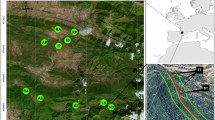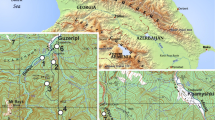Abstract
Ecologists are not always mindful of the constraints imposed by their scale of observation and sometimes prematurely attempt broad generalisations or become mesmerised by local details depending on their predilections. We specifically chose a character that is known for its local and unpredictable variation (morphology of kelp) to test the effect of scale on our ability to determine spatial patterns. We compared the morphology of Ecklonia radiata between monospecific and mixed stands of canopy-forming algae across temperate Australia (>5,100 km coastal distance) within a hierarchy of several spatial scales. While E. radiata specimens were generally larger in monospecific than in mixed stands, we failed to observe differences in morphology between stands at many sites and locations. Despite substantial local variation, differences between stands became increasingly clear at broader scales. The frequency of inconsistent differences between stands was greatest at local scales (sites separated by kms), intermediate at intermediate scales (locations separated by 100s of kms) and least at regional scales (regions separated by 1,000s of kms). These observations support the idea that large scale patterns can emerge from apparent stochasticity at small scales, and that unaccountable variation at local scales need not impede tests for similar patterns at broader scales. Most ecologists work at scales where complexity tends to be greatest (i.e. local) and is likely to be explained by special and unique events. It is encouraging, therefore, to observe that patterns can emerge from complexity at local scales to provide new opportunities to answer some of the more interesting questions about the relative importance of processes across the vast parts of the world’s coast.



Similar content being viewed by others
References
Anderson MJ (2001) A new method for non-parametric multivariate analysis of variance. Aust Ecol 26:32–46
Anderson MJ, Connell SD, Gillanders BM, Diebel CE, Blom WM, Landers TJ, Saunders JE (2005) Relationships between taxonomic resolution and spatial scales of multivariate variation in kelp holdfast assemblages. J Anim Ecol (in press)
Andrew NL, Viejo RM (1998) Effects of wave exposure and intraspecific density on the growth and survivorship of Sargassum muticum (Sargassaceae: Phaeophyta). Eur J Phycol 33:251–258
Barnes PW, Beyschlag W, Ryel R, Flint SD, Caldwell MM (1990) Plant competition for light analyzed with a multispecies canopy model. Oecologia 82:560–566
Benedetti-Cecchi L (2003) The importance of the variance around the mean effect size of ecological processes. Ecology 84:2335–2346
Blanchette CA (1997) Size and survival of intertidal plants in response to wave action: a case study with Fucus gardneri. Ecology 78:1563–1578
Blanchette CA, Miner BG, Gaines SD (2002) Geographic variability in form, size and survival of Egregia menziesii around Point Conception, California. Mar Ecol Prog Ser 239:69–82
Cappo M, Walters CJ, Lenanton RC (2000) Estimation of rates of migration, exploitation and survival using tag recovery data for western Australian “salmon” (Arripis truttaceus: Arripidae: Percoidei). Fish Res 44:207–217
Cheshire AC, Hallam ND (1988) Morphology of the Southern Bull-Kelp (Durvillaea potatorum, Durvilleales, Phaeophyta) from King Island (Bass Strait, Australia). Bot Mar 31:139–148
Cheshire AC, Hallam ND (1989) Morphological differences in the Southern Bull-Kelp (Durvillaea potatorum) throughout South-Eastern Australia. Bot Mar 32:191–197
Chesson P (1996) Matters of scale in the dynamics of populations and communities. In: Floyd RB, Sheppard AW, Barro PJD (eds) Frontiers of population ecology. CSIRO, Melbourne, pp 353–368
Chesson P (2000) Mechanisms of maintenance of species diversity. Annu Rev Ecol Syst 31:343–366
Foster MS (1990) Organization of macroalgal assemblages in the Northeast Pacific: the assumption of homogeneity and the illusion of generality. Hydrobiologia 192:21–33
Fowler-Walker MJ, Connell SD (2002) Opposing states of subtidal habitat across temperate Australia: consistency and predictability in kelp canopy-benthic associations. Mar Ecol Prog Ser 240:49–56
Gerard VA (1982) In situ water motion and nutrient uptake by the giant kelp Macrocystis pyrifera. Mar Biol 69:51–54
Gerard VA, Mann KH (1979) Growth and production of Laminaria longicruris (Phaeophyta) populations exposed to different intensities of water movement. J Phycol 15:33–41
Goodsell PJ, Fowler-Walker MJ, Gillanders BM, Connell SD (2004) Variations in the configuration of algae in subtidal forests: Implications for invertebrate assemblages. Aust Ecol 29:350–357
Gower JC (1967) A comparison of some methods of cluster analysis. Biometrics 23:623–627
Green RH (1979) Sampling design and statistical methods for environmental biologists. Wiley, New York
Hurd CL (2000) Water motion, marine macroalgal physiology, and production. J Phycol 36:453–472
Irving AD, Connell SD, Gillanders BM (2004) Local complexity in patterns of canopy-benthos associations produce regional patterns across temperate Australasia. Mar Biol 144:361–368
Kalvas A, Kautsky L (1998) Morphological variation in Fucus vesiculosus populations along temperature and salinity gradients in Iceland. J Mar Biol Assoc UK 78:985–1001
Kassahn KS, Donnellean SC, Fowler AJ, Hall KC, Adams M, Shaw PW (2003) Molecular and morphological analyses of the cuttlefish Sepia apama indicate a complex population structure. Mar Biol 143:947–962
Kirkman H (1981) The first year in the life history and the survival of the juvenile marine macrophytye, Ecklonia radiata (Turn.) J. Agardh. J Exp Mar Biol Ecol 55:243–254
Lawton JH (1999) Are there general laws in ecology? Oikos 84:177–192
McIntosh RP (1980) The background and some current problems of theoretical ecology. In: Saarinen E (ed) Conceptual issues in ecology. Reidel, Dordrecht, pp 1–61
Menge BA, Sanford E, Daley BA, Freidenburg TL, Hudson G, Lubchenco J (2002) Inter-hemispheric comparison of bottom-up effects on community structure: insights revealed using the comparative-experimental approach. Ecol Res 17:1–16
Molloy FJ, Bolton JJ (1996) The effects of wave exposure and depth on the morphology of inshore populations of the Namibian kelp, Laminaria schinzii foliose. Bot Mar 39:525–531
Noda T (2004) Spatial hierarchical approach in community ecology: a way beyond high context-dependency and low predictability in local phenomena. Pop Ecol 46:105–117
Novaczek I (1981) Stipe growth rings in Ecklonia radiata (C.AG.) J.AG. (Laminariales). Br Phycol J 16: 363–371
Peters RH (1991) A critique for ecology. Cambridge University Press, Cambridge
Podani J (1999) Extending Gower’s general coefficient of similarity to ordinal characters. Taxon 48:331–340
Poore GCB (1994) Marine biogeography of Australia. In: Hammond L, Synnot R (eds) Marine biology. Longman Cheshire, Melbourne, pp 189–212
Quinn GP, Keough MJ (2002) Experimental design and data analysis for biologists. Cambridge University Press, Cambridge
Rice EL, Kenchington TJ (1990) Spatial variation patterns in the marine macroalgal Xiphophora gladiata spp. Gladiata (Phaeophyta). I. Partitioning of morphological variation into spatial scales. J Phycol 26:508–522
Rice EL, Kenchington TJ, Chapman ARO (1985) Intraspecific geographic-morphological variation patterns in Fucus distichus and Fucus evanescens. Mar Biol 88:207–215
Rochford DJ (1972) Nutrient enrichment of east Australian coastal waters. CSIRO Div Fish Oceanogr Tech Paper No. 33
Sjøtun K, Fredriksen S (1995) Growth and allocation in Laminaria hyperborea (Laminariales, Phaeophyceae) in relation to age and wave exposure. Mar Ecol Prog Ser 126:213–222
Tranter DJ, Carpenter DJ, Leech GS (1986) The coastal enrichment effect of the East Australian Current eddy field. Deep-Sea Res 33:1705–1728
Underwood AJ (1997) Experiments in ecology. Their logical design and interpretation using analysis of variance. Cambridge University Press, Cambridge, UK
Underwood AJ, Chapman MG (1996) Scales of spatial patterns of distribution of intertidal invertebrates. Oecologia 107:212–224
Underwood AJ, Petraitis PS (1993) Structure of intertidal assemblages in different locations: how can local processes be compared? In: Ricklefs R, Schluter D (eds) Species diversity in ecological communities. University of Chicago Press, Chicago, pp 38–51
Underwood AJ, Chapman MG, Connell SD (2000) Observations in ecology: you can’t make progress on processes without understanding the patterns. J Exp Mar Biol Ecol 250: 97–115
Wernberg T, Coleman M, Fairhead A, Miller S, Thomsen M (2003) Morphology of Ecklonia radiata (Phaeophyta: Laminarales) along its geographic distribution in south-western Australia and Australasia. Mar Biol 143:47–55
Wiens JA (1989) Spatial scaling in ecology. Funct Ecol 3:385–397
Womersley HBS (1981) Biogeography of Australasian marine macroalgae. In: Clayton MN, King RJ (eds) Marine botany: an Australian perspective. Longman Cheshire, Melbourne, pp 292–307
Acknowledgements
This paper benefited from the subject of study (morphology) which typifies scientific discussion; the weight of scientific uncertainty is positively related to the strength of scientific opinion. We specifically thank spirited discussions with M. Coleman, T. Elsdon, P. Goodsell, A. Irving, E. Vytopil, T. Wernberg and anonymous reviewers. We thank M. Anderson for a custom-made copy of NPMANOVA and continuing discussion on applying conceptual and quantitative ideas across broad areas of our experience. This work was supported by an ARC large grant to S.D.C. and B.M.G. and an ARC QEII Fellowship to B.M.G.
Author information
Authors and Affiliations
Corresponding author
Additional information
Communicated by M.S. Johnson, Crawley
Rights and permissions
About this article
Cite this article
Fowler-Walker, M.J., Connell, S.D. & Gillanders, B.M. Variation at local scales need not impede tests for broader scale patterns. Marine Biology 147, 823–831 (2005). https://doi.org/10.1007/s00227-005-1605-x
Received:
Accepted:
Published:
Issue Date:
DOI: https://doi.org/10.1007/s00227-005-1605-x




